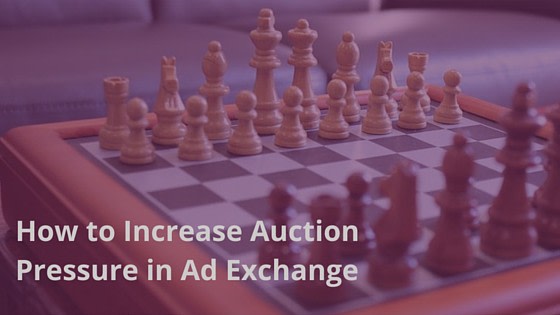
This post was most recently updated on September 5th, 2019
The main goal of yield optimization is revenue gain. One of the fundamental principles that we utilize to increase our publishers’ ad revenue is to get the advertisers to pay closer to, if not exactly, their top bid. This is done by increasing auction pressure in Ad Exchange.
Advertising through different ad networks like AdSense and other real-time bidding networks is established by an auction. Just like in a real-life auction, the final price is most of the time quite different from what the buyer is willing to pay. In the online world, unfortunately, the auction is adjusted in favor of the buyer.
For publishers running Ad Exchange, one way to compel advertisers to pay closer to their maximum bid is to set a minimum price for your inventory. Publishers can set floor prices for many different combinations of criteria and manage it to push the advertisers to pay closer to the maximum value of the impression.
Setting these floor prices is very useful but it’s only one of many solutions. This strategy requires constant attention and can be costly if not managed well.
An increase in the auction pressure normally leads to an increase in fill rate followed by an increase in revenue. By removing the restriction on bids eligible for your inventories, you increase the auction pressure.
Below are some ways to do that:
Limit or remove category blocking. Blocking an entire category of advertisers diminishes the auction pressure for a large number of impressions.
Often publishers block entire categories in order to exclude all ads from that source or improve the quality of ads that serve to users.
Every blocked category reduces the number of ads within an auction and decreases competition, resulting in lower CPMs for the winning ads. Unblocking categories increase auction competition in Ad Exchange.
Also, consider moving blocks from the “Everything” rule (blocking at the account level) to specific rules only. This still protects your inventory where necessary but also opens up inventory on less restricted sites.
Implementation
To remove category blocks:
Often publishers block entire advertiser URLs in order to exclude all ads from that source or improve the quality of ads that serve to users.
Every blocked advertiser URL reduces the number of ads within an auction and decreases competition, resulting in lower CPMs for the winning ads. Unblocking advertiser URLs increases the auction pressure in Google Ad Exchange and overall yield.
You may also want to consider moving blocks from the “Everything” rule (blocking at the account level) to specific rules only. This still protects your inventory where necessary but also opens up inventory on less restricted sites.
Implementation
To remove advertiser URL blocks:
Most buyers who bid on Ad Exchange are for branded inventory. By enabling branded targeting on your rules, you should see significant increases in CPM due to the large demand for branded inventory in the Exchange.
Implementation
You can enable branded targeting at the account or rule level directly in the Ad Exchange UI.
First, you must identify if your account and rules are set up to accept branded buyers. If not:
At any time, you can view how your inventory is transacting with branded reporting, which is available from the “Reporting” tab. You can view data at the buyer or advertiser level.
Enabling both text and image ads to compete for your ad inventory drives auction pressure, potentially resulting in increases in both match rate and eCPM.
Agency budgets are typically earmarked for both reserved buys and automated bidding, so allowing display inventory to compete enables you to capture demand for automated bidding through trading desks and DSPs.
Google AdWords is currently the largest buyer of inventory on the Ad Exchange and serves mostly text ads. To make the most of your inventory, we also recommend enabling AdWords to act as a buyer.
Implementation
To enable text and image ads:
Consider additional networks and technologies. These bring more advertisers to the table.
Ad Exchange enables you to opt into ad technologies to prevent unwanted vendors from running on your site. However, you may be missing out on additional revenue if you don’t opt into enough ad technologies.
Our studies show that opting into ad technologies can increase demand flowing through the system and thereby drive more revenue, increasing your CPM.
We recommend that you review ad technologies frequently to ensure that you’re able to opt into new technologies on the Ad Exchange.
Implementation
The ad technologies with the most revenue flowing through them are ad verification vendors such as DoubleVerify and AdSafe, so you may want to consider opting into these vendors.
To opt into ad technologies:
Get more from your ad inventory by boosting advertiser competition to increase auction pressure. Contact us for a free consultation today and find out how.
KNOW MORE ABOUT AD EXCHANGE OPTIMIZATION:

Kean Graham is the CEO and founder of MonetizeMore & a pioneer in the Adtech Industry. He is the resident expert in Ad Optimization, covering areas like Adsense Optimization,GAM Management, and third-party ad network partnerships. Kean believes in the supremacy of direct publisher deals and holistic optimization as keys to effective and consistent ad revenue increases.
10X your ad revenue with our award-winning solutions.